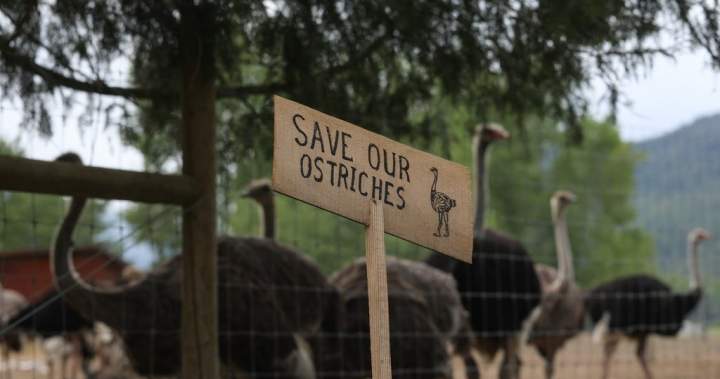In an unexpected twist to British Columbia’s controversial ostrich saga, a Texas-based social media influencer has stepped forward with a bold proposal to rescue the flightless birds from their pending fate. As provincial authorities move ahead with plans to euthanize dozens of abandoned ostriches roaming the wilderness near Armstrong, this cross-border intervention has ignited fresh debate about wildlife management and animal rescue efforts.
The ostriches, initially left to fend for themselves following the abrupt closure of a local farm, have become an increasingly complex wildlife management challenge for BC authorities. Over recent months, the large birds have wandered through rural communities, disrupted local ecosystems, and posed potential hazards to motorists and residents.
“These birds didn’t ask to be brought to Canada and certainly didn’t ask to be abandoned,” said Kourtney Kardez, the Texas influencer who operates a 70-acre animal sanctuary outside Houston. “When I heard about the planned cull, I immediately reached out to provincial officials with an alternative—I have the space, resources, and expertise to give these birds a permanent home.”
According to documents obtained from the BC Ministry of Environment, the province initially determined euthanasia was the most practical solution after failing to locate suitable rescue options within Canada. Officials cited concerns about the birds’ adaptation to the wild, disease transmission risks, and the considerable resources required to safely capture and relocate such large birds.
Provincial spokesperson Ellen Woodsworth confirmed receipt of the Texas offer. “We appreciate all sincere offers to assist with this challenging situation,” she told CO24 News. “However, there are significant regulatory hurdles involved in transporting wildlife across international borders, including permits, health certifications, and quarantine requirements. We’re currently assessing the feasibility of this proposal alongside other options.”
Wildlife experts remain divided on the best approach. Dr. Marcus Chen, veterinarian and exotic animal specialist at the University of British Columbia, notes the complexity of the situation. “While euthanasia is never anyone’s preferred option, we must consider what’s truly in the best interest of these animals and the ecosystem. Ostriches are not native to North America, and their presence creates ecological disruptions that shouldn’t be minimized.”
The saga has gained substantial traction on social media, with Kardez’s video plea garnering over three million views since posting last week. Her sanctuary, originally established for rescued farm animals, has expanded in recent years to include several exotic species. “We already care for emus and rheas, which are similar ratites to ostriches,” Kardez explained. “We have the experience and facilities to provide these birds with appropriate care for the remainder of their natural lives.”
Community response in Armstrong has been mixed. Local farmer Juanita Bergstrom expressed frustration at the situation’s complexity. “These birds have damaged property and scared livestock. While nobody wants to see them killed, we need a resolution that works for everyone, including our community.”
The BC Wildlife Federation has weighed in, calling for careful consideration of all available options. “This situation highlights the need for stronger regulations regarding exotic animal ownership and more robust contingency planning,” said federation president Carlos Menendez in a statement to CO24 Canada News.
As provincial authorities evaluate the Texas sanctuary offer, they face mounting pressure from animal rights activists who have organized protests in Victoria and Vancouver. Meanwhile, wildlife officers continue monitoring the ostrich population, which has reportedly grown more dispersed in recent weeks as the birds adapt to their surroundings.
This unusual wildlife management challenge raises important questions about our responsibilities toward non-native species introduced by human activity. As we navigate these complex ethical waters, perhaps we should ask ourselves: When exotic animals are abandoned through no fault of their own, who ultimately bears responsibility for their welfare, and what solutions truly serve both ecological balance and compassionate treatment?










